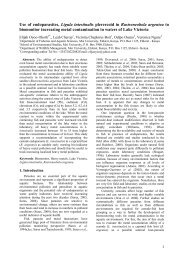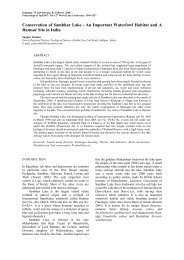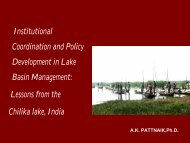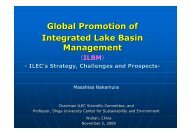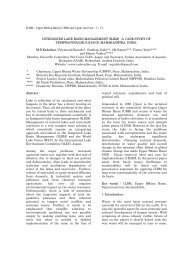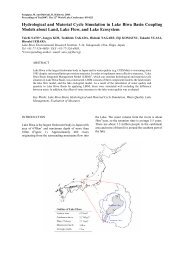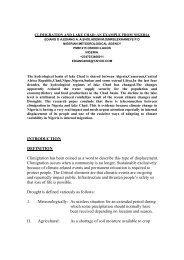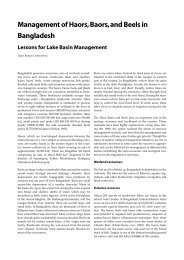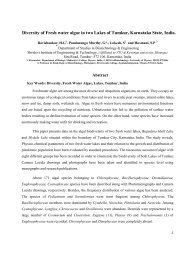Lake Chapala Management - World Lake Database
Lake Chapala Management - World Lake Database
Lake Chapala Management - World Lake Database
You also want an ePaper? Increase the reach of your titles
YUMPU automatically turns print PDFs into web optimized ePapers that Google loves.
issues [9]. Generally speaking there is a lack of public<br />
access to information and just few cases of<br />
organizative development linked to improvement of<br />
social, productive and ecological processes.<br />
It’s relevant mention that Lerma-<strong>Chapala</strong> basin shows<br />
depletion of underground water (1 to 5 meters, varying<br />
depending of the particular aquifer) and that most<br />
frequent struggles have happened between irrigation<br />
farmers and Guadalajara City users. This situation<br />
increases dramatically when lake <strong>Chapala</strong> reduces its<br />
volume derived of scarce rain and water retention in<br />
the upper and middle basin.<br />
Federal government created the Lerma-<strong>Chapala</strong> Basin<br />
Council back in 1989 as a mechanism to reach<br />
agreements and solve problems related to basin’s water<br />
use, but despite several advances in that issue this<br />
space has been perceived (and frequently used) as a<br />
political arena, often ignoring matters of water<br />
recharge linked to territorial use (basin management).<br />
Also due to conflictive points of view of participants<br />
(representatives of urban, industrials and agricultural<br />
uses, besides five state governments), the federal<br />
government usually has used a very cautious approach<br />
that generated slow changes. The Basin Council<br />
emphasizes the role of water users and water agencies,<br />
usually ignoring links between rivers with <strong>Lake</strong><br />
<strong>Chapala</strong>, forest management, crop planning and urban<br />
development issues related to water recharge, quality<br />
and volume. Also receiving small consideration are the<br />
paper of researchers, universities, environmental<br />
agencies and civil society organizations, which rarely<br />
gained access to the council and only as speakers.<br />
2. The Integrated <strong>Lake</strong> Basin <strong>Management</strong><br />
(ILBM) in Lerma <strong>Chapala</strong> basin.<br />
2.1 ILBM Structure and origins<br />
ILBM is a conceptual framework for assisting lake<br />
managers and stakeholders in achieving sustainable<br />
management of lakes and their basins. It takes into<br />
account the biophysical features as well as managerial<br />
requirements for lake basin systems, that are<br />
associated with the lentic water properties of lakes as<br />
well as the inherent dynamics between humans and<br />
nature in the process of development, use and<br />
conservation of lake and basin resources [10]. It was<br />
developed as result of a Global Environment Facility<br />
(GEF) project conducted by the International <strong>Lake</strong><br />
Environment Committee Foundation (ILEC), a<br />
scientific group based in Japan, which analyzed and<br />
summarized the experiences of 28 lake basins around<br />
the world [11]. The experiences learned from the GEF-<br />
ILBM project indicate that good lake basin<br />
management requires: a) Institutions to manage the<br />
lake and its basin for the benefit of all lake basin<br />
resources uses, b) Policies to govern people’s use of<br />
lake resources and their impact on lakes, c)<br />
Involvement of people, central to lake basin<br />
management, d) Technological possibilities and<br />
limitation that exist in almost all cases, e) Knowledge,<br />
both of a traditional and scientific nature is valuable,<br />
and f) Sustainable finances to fund from all of the<br />
above activities. These constitute the essential six<br />
pillars of basin governance about which ILBM can<br />
provide the overall framework for application.<br />
2.2 Applying ILBM in the Lerma-<strong>Chapala</strong> basin:<br />
first steps.<br />
Despite the importance of ILBM as a powerful tool for<br />
lake basin management it was scarcely known in<br />
Mexico and Latin America. Understanding its value to<br />
foster the Lerma-<strong>Chapala</strong> basin management and to<br />
overcome the frequent basin users’ quarrels, Corazon<br />
de la Tierra, a Mexican Civil Society Organization<br />
(CSO) invited ILEC to take part in an Expert<br />
Workshop and Open Forum named “<strong>World</strong> <strong>Lake</strong><br />
Vision: constructing an Action Plan for <strong>Lake</strong> <strong>Chapala</strong><br />
Basin”, held from November 1 st to 4 th , 2006. As result<br />
of the intense three days work of 18 participants (12<br />
Mexican and 6 foreigners, each one an expert in their<br />
own field) a proposal of Action Plan for the Lerma-<br />
<strong>Chapala</strong> Basin was created, which was then presented<br />
to a wide group of stakeholder representatives (117<br />
participants coming from the five states of the basin,<br />
including municipal, state and federal government<br />
levels; universities, civil organizations, farmers, etc.)<br />
This diverse set of people received the information,<br />
analyzed and complemented it, finally generating 135<br />
lines of action integrated in six Strategies: Optimal use<br />
of water; Prevention and control of water pollution;<br />
Biodiversity management; Social involvement for<br />
basin management; Monitoring of lake and its basin;<br />
and Sustainable management models. The fact that a<br />
proposal of this kind could be so widely structured,<br />
based in sound scientific information and experience<br />
from the expert participants and then backed up by the<br />
wide range of attendants was unprecedented. The<br />
document was checked and edited, comprising lines of<br />
action to 117 to publicly present the document in<br />
March 22 nd 2007, as part of the <strong>World</strong> Water Day [12].<br />
Unfortunately 2006-2007 was a period of deep<br />
administrative changes in federal, states and municipal<br />
government levels, immediately after political elections.<br />
So, most of 2007 and half 2008 were used for lobbying<br />
the Action Plan document with new officers, to let<br />
them know its thematic contents and to convince them<br />
about its importance. A common perception was that<br />
the Action Plan was (quoting a federal officer) “too<br />
inclusive and extensive” meaning that no institution<br />
could accomplish to aboard it completely and that<br />
several stakeholders were needed to work together to<br />
reach shared goals. As a result a frequent reaction was<br />
to decline participation because that represented high<br />
effort and (apparently) little political gain.<br />
Nevertheless several allies were found in the process,<br />
highlighting involvement of Jalisco’s state government



